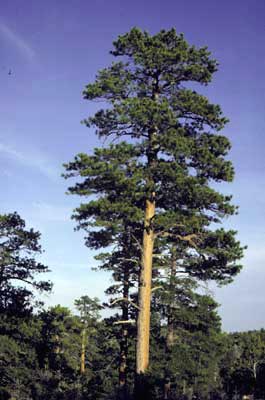Ponderosa Pine

Scientific Name:
Pinus ponderosa Laws.
Scientific Name Synonyms:
None known
Symbol:
PIPO
Description:
Life Span: Perennial
Origin: Native
Season: Evergreen
Growth Characteristics: Ponderosa pine has a long clear trunk and a high short open crown. It averages 42 inches in diameter and 165 feet tall at maturity.
Flowers/Inflorescence: Male and female cones are separate but found on the same tree. The male cones are small, yellowish, and in clusters. Female cones average 4 inches in length when mature. The tips of the cone scales are armed with short, sharp, outcurved prickles. The female cones, like all pines, require two growing seasons to mature.
Fruits/Seeds: Small seeds, about ¼ inch long, with a broad terminal wing about 1 inch long.
Leaves: Needle-like, in "bundles" of threes, occasionally in two's. The leaves are stout, dark to yellow-green, and about 7 inches in length. The leaves remain attached and continue growing for approximately 5 years. Buds are resinous, reddish-brown, and about ½ inch long.
Stems: Twigs are usually coarse, stout and orange-yellow. Bark is gray to black and scaly on young trees. As the trees reach maturity, the bark thickens to as much as 4 inches and breaks into large, flat, yellow-brown, scaly-topped plates separated by deep furrows. Old trees have a characteristic yellow bark and are locally named Yellow Pine. The bark has a fragrance of vanilla or butterscotch. The wood is highly desirable, light in weight, rather hard, strong, and relatively fine-grained. The branches of ponderosa pine are self-pruning.
Ecological Adaptions:
Ponderosa pine is common in mountain and plateau areas at elevations between 5,700 and 8,900 feet. It develops a taproot early in life, which helps it to survive extended drought periods, especially long, dry summers. Ponderosa pine reaches maturity in 300 to 400 years.
Soils: Gravelly loams of canyon bottoms and those of igneous or metamorphic origins on mesa tops and mountain slopes.
Associated Species: Douglas fir, blue spruce, Engelmann spruce, white fir, aspen, and limber pine.
Uses and Management:
Ponderosa pine, historically as well as presently, is one of the most valuable saw timber trees in the state. The tree has had many uses including: poles, saw timber, railroad ties, mine timbers, and fuel.
Ponderosa pine communities are important wildlife habitat. The forest understory provides valuable browsing and grazing for wildlife and livestock. Wildlife also use ponderosa pine woodland-grassland mosaics heavily. Meriams turkeys roost in stands of ponderosa.
Ponderosa pine is unpalatable to domestic livestock. Cattle generally browse ponderosa pine seedlings only when herbaceous forage is scarce. When herbaceous vegetation is sparse, however, livestock may browse ponderosa pine enough to slow or stop seedling recruitment. Pregnant cows that consume large amounts of ponderosa pine needles during cold spells show an increased incidence of abortion and other reproductive anomalies.
Native Americans ate ponderosa pine seeds and the sweet, edible phloem in the inner bark. The Cheyenne Indians of Montana applied ponderosa pine pitch inside whistles and flutes to improve the instruments' tone. They made blue dye from a root extract. The Nez Pierce used the pitch as a torch fuel; the Nez Pierce and Crow also used pitch as glue.

